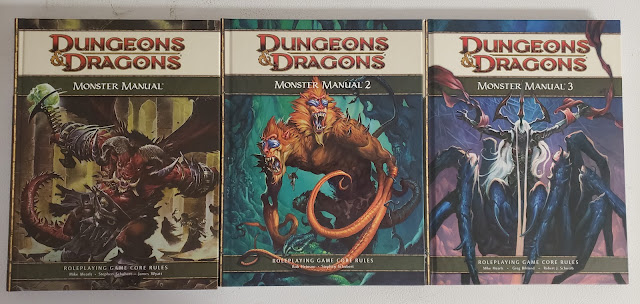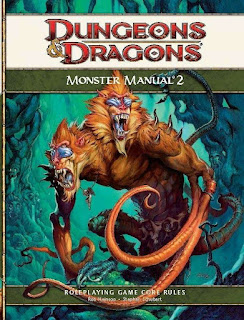A few months back I went through a number of the AD&D 2nd ed Monstrous Compendiums and talked about the advantages and disadvantages it had over the 1st ed Monster Manual. Also at the time, I mentioned the design choices made that also separated them from their 1st edition counterparts.
Since today is the 4th of the month, I figure it is a good time to talk about the Fourth Edition Monster Manuals and what also made them special.
To begin with, I was and am a fan of 4th Edition Dungeons & Dragons. I know it was not everyone's favorite edition, to put it mildly, but there are some really great things about it. For starters, I applaud the design team for daring to try something new and different with the D&D game. Of course, most fans don't want new. They want the same thing, but even for the open-minded D&D 4 was a bridge too far. Secondly, D&D 4 was a masterwork of modular design. You could take out and move around sections of it as you needed. Yes, everything worked together, but many of the pieces could be swapped out for other pieces. This design notion extended to the layout of the books. Nowhere is this better seen than with the Monster Manuals.
To me it seemed that 4th edition took the design elements that had made the Monstrous Compendiums successful; namely one monster per page, and all sorts of information on the monster's habitat, environment, and variations. It is also one of the main reasons I still keep my 4th edition monster books. There is so much information here that I have been using them to inform details in my 5th edition game.
In all cases here, I am considering my hardcover books and the PDFs from DriveThruRPG.
Monster Manual for D&D 4e
Hardcover and PDF. Color covers, full-color interior art. 288 pages.
This was the third book published for D&D 4th edition, though that is a mere technicality since all books were published at the same time in June of 2008. I picked mine up as a boxed set at the midnight release.
Much like AD&D second edition, the monsters for D&D 4th edition are presented as one page per monster. More or less. Sometimes the monster runs two or four pages, but always a complete page. Where 3e had monsters built exactly like characters, 4e monsters have their own rules, much like how 1st and 2nd Ed built them.
Fourth Edition was most certainly a "miniatures" game or, as it was hoped, to have a lot of online support and content. That did not materialize in the way Wizards of the Coast wanted and strong sales of Paizo's rival "Pathfinder RPG" kept D&D sales low for the first in the history of RPGS. Make no mistake, D&D still sold well, it just wasn't out selling everything else.
That was too bad really. D&D 4 had a lot about it I liked and still like.
The 4e Monster Manual is 288 pages with over 170 monster entries. Many entries have multiple monsters. For example, there are three different types of Aboleth, six types of kobolds, and seven types of orcs. Along with the stat blocks, we get an idea of the role each monster plays in combat, like Controller, Brutes, Skirmishers, or Leaders, and what tactics they can employ. All the monsters have Lore with appropriate DCs for learning more about them or what a particular die roll will bring up. The monsters also include plot hooks and ideas for using them in adventures.
Some interesting changes happened in 4e. For starters, some major demons, like our cover guy Orcus here, got their own entry outside of the demons category. He also had major henchmen listed with him.
Also, a conscious effort was made to redesign the cosmology of D&D. The effect here was to have Succubi now listed as "Devils" and not "Demons."
This caused some interesting in-game fluff with books like Erin M. Evans' "Brimstone Angels" trying to explain this "in-universe" from the perspective of the Forgotten Realms. This lives on in 5e with succubi as now independent evil outsiders. Other changes were made to various monsters, Daemons/Yugoloths we moved over to the demons, including making them Chaotic Evil. This might have messed with ideas of the Blood War, but there is no reason why there needs to be continuity between editions, it is just nice.
One of the things that irritated some people was not the monsters it had, but the ones it did not have. It particular Demogorgon is nowhere to be found and many of the named devils are also not here.
Hardcover and PDF. Color covers, full-color interior art. 224 pages.
This book was published about a year later in May of 2009. This book also has over 170 monster entries. Some are expanded, like Giants (and I love what they did for giants in this edition) and more demons. This book also gives the impression that many monsters were held back for a second book. Unlike previous books with the same name, Monster Manual 2, this one doesn't feel like added-on monsters. This feels more like the Vol 2 of the AD&D Monstrous Compendium. In addition to some that are expected, there are some new monsters too.
Our cover guy this time is Demogorgon. He and all his minions get 9 pages.
Hardcover and PDF. Color covers, full-color interior art. 224 pages. This is also the only book of the three that you can also buy as a Print on Demand softcover.
This book was released in June 2010, another year after the MM2. Lolth is our cover girl this time. It would have been interesting to see Graz'zt, but Lolth makes sense too. Eclavdra also shows up in Lolth's entry.
Page for page, this one has a lot more new monsters. Not just new to D&D 4, but new to D&D. These include the new Catastrophic Dragons which I had been looking forward to. There are a lot of new monsters and some additions to MM1 & MM2 ones, like new Fire Giants. That is one of the features of this edition, each variation of a monster needs a new stat-block. To be fair, D&D 3 and D&D 5 also did this a fair bit.
The layout is such, that like the AD&D 2nd Edition Monstrous Compendiums, the D&D 4th Edition Monster Manuals PDFs can be printed out with just the monsters you want and organized in a binder. The modularity of the design is so well planned out that it really makes me want to print out these PDFs and just make my own Monstrous Compendium style binder for it. Sure the page numbering will be wonky, but that would not matter, everything will be perfectly alphabetized. I could even re-integrate demons like Orcus and Lolth back to where they belong under demons.
The art is amazing really. The visual style of the monsters flows from the 3rd Edition monster books to provide a sense of continuity even if the worlds do feel different.
I am not currently playing D&D 4th Edition, but I find these monster books still so incredibly useful even in my D&D 5th Edition and Basic/Expert edition games. They are also just great-looking books.
If you are curious, there is a list of all the 4th Edition monsters.








5 comments:
Aw, you left out the very best of all the 4e monster books, the Nentir Vale Monster Vault. 4e just kept getting better and better at monster design as time went by, and the Essentials and Vault books really show off how polished things had gotten.
I am doing that one on it's own.
I really loved the multiples options for a single type of monster to differentiate their roles in combat. It seems to me that the new Volo's Guide is doing something similar with the base humanoid monster types.
Oh good, looking forward to it.
The Essentials era was peak 4e in my book, they'd really taken their advice in DM2 to heart by then.
I did love the 4e stat blocks! All-in-one monster rules, no looking somewhere else for spells or reading a half page of description about a special ability. The economy of terminology in 4e was very good. The more natural language style of 5e is easier to read and feels more narrative at baseline, but 4e was better as a reference of clearly defined rules.
Anyway, are you going to look at the Demonomicon as well?
Post a Comment